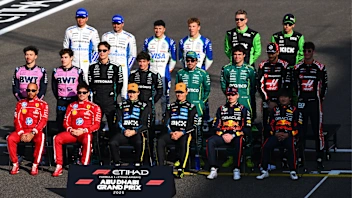After teasing us with a generic car to show the team’s new livery, the real Williams FW44 broke cover later in the day in a shakedown at a wet Silverstone. Mark Hughes takes a closer look.
READ MORE: Williams reveal striking blue 2022 livery for their FW44 challenger
Highly distinctive sidepods
This is a massively differentiated design, particularly around the FW44's sidepod and engine cover. It would appear the Williams designers have concentrated much of the cooling systems up towards the front of the sidepod (and given it big radiator inlets there) but then shrink-wrapped the sidepod as tightly as possible so that it slims down dramtically further back.
The pods are shorter and more heavily ramped downwards than any other 2022 design seen so far. The engine cover inlet is also unusually large, suggesting that the cooling route for the intercooler is through there. This has enabled a dramatically cut-back sidepod lower down.
Rather than creating an undercut, once it is behind those big radiator inlets the lower bodywork almost dissolves away, creating a big channel along the side for the airflow to make its way between the rear wheels and the tunnel exits.
The suspension is the conventional arrangement of pushrod front/pullrod rear (as seen also on the Aston Martin and AlphaTauri but not the McLaren).

Underbody priority
The relatively high front wing visually accentuates just how much priority is being given to feeding the underbody venturi tunnels.
The wing elements on the car at Silverstone were relatively flat and very simple in profile, though we’d expect to see more cambered elements for use on higher-downforce tracks.
The bottom wing element stands proud of the tip of the nose, as seems to be common – but not universal – with this year’s crop of cars. This will help the flow to attach to the underside of the nose more cleanly, again optimising that flow to the leading edge of the floor and the tunnel inlets.
ANALYSIS: The fascinating design features – and Red Bull cues – on AlphaTauri’s AT03

This year, Williams take the Mercedes gearbox (previously they made their own) and the associated hydraulics, but still design and manufacture their own suspension.
That whole area is highly visible on the Williams courtesy of the pared back bodywork. Compared to, say, the AlphaTauri, the area atop the venturi ramps sits naked adrift of the sidepods, underlining the very different approaches taken with cooling routes.
This one should give a good air pressure differential between the air flowing out through the tunnel and that travelling over the top, which should help enhance the speed of underbody airflow.
The FW44, which hopefully will go as well as it looks, represents yet another highly particular interpretation of the new regulations.
More on the 2022 Formula 1 car launches
Massive variation and ingenious solutions – What we learned from the first week of 2022 launches
ANALYSIS: Williams forge their own path with FW44 design
ANALYSIS: The key feature on the MCL36 that McLaren are hoping will give them an edge on rivals
ANALYSIS: The intriguing design features on Aston Martin’s new AMR22
ANALYSIS: What Haas’ VF-22 can teach us about how teams have approached the 2022 regulations
ANALYSIS: The fascinating design features – and Red Bull cues – on AlphaTauri’s AT03
Next Up
Related Articles
.webp) ExclusiveZhou on why he has ‘high trust’ in Cadillac project
ExclusiveZhou on why he has ‘high trust’ in Cadillac project.webp) 7 things to be excited for in the 2026 F1 season
7 things to be excited for in the 2026 F1 season ExclusiveThe top 10 drivers of 2025 – as chosen by the drivers
ExclusiveThe top 10 drivers of 2025 – as chosen by the drivers End Of Year Reports 2025McLaren’s best and worst moments from 2025
End Of Year Reports 2025McLaren’s best and worst moments from 2025 F1 AcademyThe best off-track stories of the F1 ACADEMY season
F1 AcademyThe best off-track stories of the F1 ACADEMY season Hadjar details what excites him most about racing for Red Bull
Hadjar details what excites him most about racing for Red Bull

.webp)